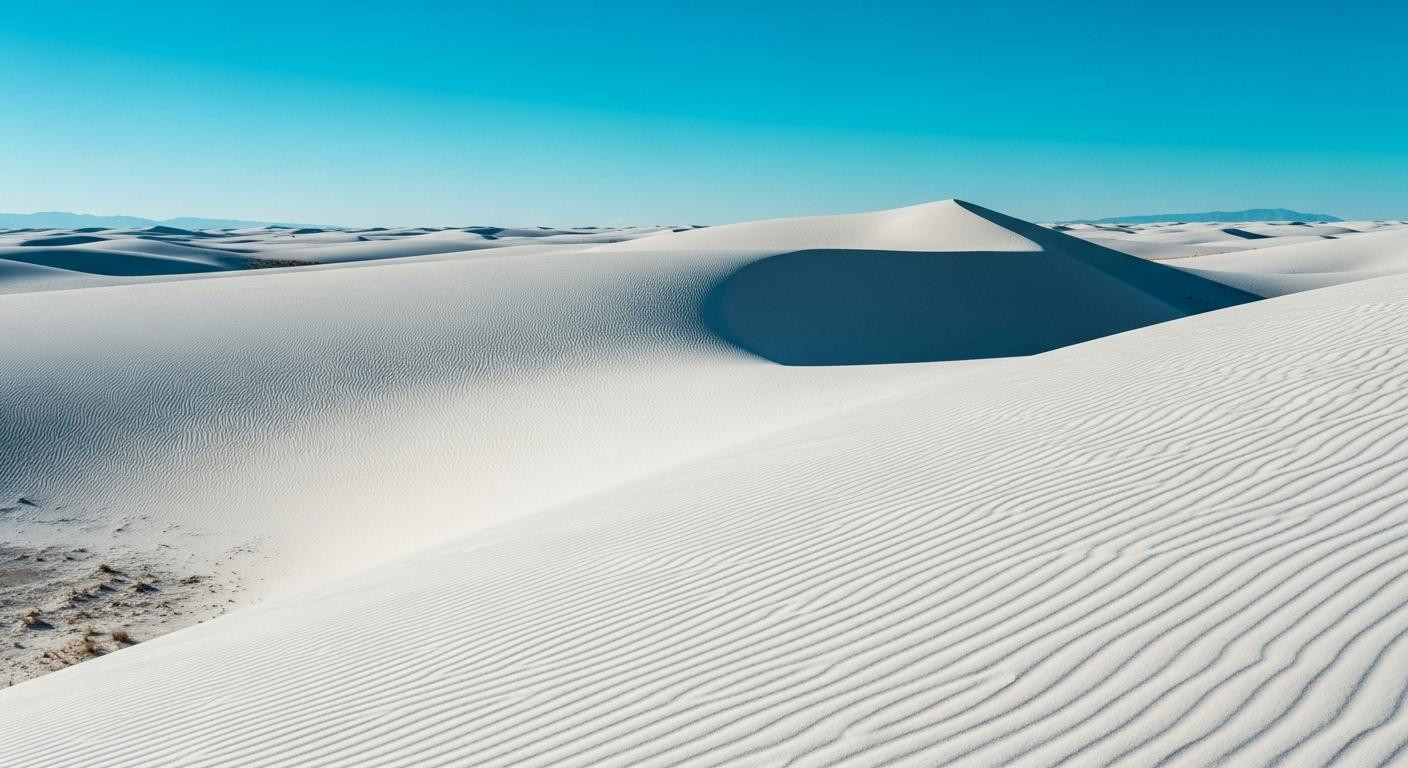Dawn breaks over Canyonlands’ Needles District at 6:47 AM. No tour buses disturb the silence that blankets red sandstone spires.
The visitor center counter reads “184 visitors” from yesterday. Yosemite processes that number by 7:15 AM on any given day.
This reveals America’s hidden network: 10 national parks where one-day exploration delivers geological drama, wildlife encounters, and transformative solitude that famous destinations commercialized away. From Utah’s red rock amphitheaters to Kentucky’s endless caves, these underrated sanctuaries cost half what crowded icons charge while offering experiences guidebooks overlook.
The white desert America forgot exists
White Sands National Park emerges from southern New Mexico like Antarctica relocated to the Chihuahuan Desert. 275 square miles of pure gypsum dunes glow impossibly white against turquoise sky.
While 4.5 million tourists photograph Grand Canyon’s commercialized overlooks 400 miles west, only 702,236 visitors discovered this otherworldly landscape in 2024. The 8-mile Dunes Drive delivers complete access in three hours.
Rangers lead full moon hikes when dunes luminescence rivals fresh snow. Gateway town Alamogordo hotels charge $98 per night versus $350 at Grand Canyon Village for identical desert proximity.
Where geological time stands visible
These parks preserve what tourist infrastructure erased elsewhere: unmediated encounters with Earth’s ancient processes. Badlands National Park’s 244,000 acres tell 75 million years of geological history in layered sediment.
The 31-mile Badlands Loop Road delivers complete traverse through landscapes resembling Mars. North Cascades’ 312 glaciers create alpine drama matching Switzerland’s Bernese Oberland minus $50 cable car tickets.
Landscapes tourist crowds never photograph
Pinnacles’ volcanic spires offer rock climbing two hours from San Jose. 240,000 annual visitors explore formations rivaling Yosemite’s granite walls without advance reservations.
Isle Royale’s 25,000 yearly visitors encounter moose and wolves in Lake Superior wilderness. Ferry access creates authentic wildlife observation versus Yellowstone’s roadside “bear jams” among 4 million annual visitors.
The cave system longer than Carlsbad
Mammoth Cave’s 420+ mapped miles make it Earth’s longest known cave system. The 2-hour Historic Tour reveals underground rivers and Gothic Avenue’s 40-foot ceilings for $16.
Carlsbad Caverns charges $30 for self-guided descent through tour bus chaos. Cave City, Kentucky hotels average $85 per night versus $200 near Carlsbad.
One-day wilderness immersion
Each park’s compact geography enables complete exploration in eight hours. No multi-day permits or $200 backcountry camping required.
Canyonlands’ Island in the Sky District delivers 360-degree canyon vistas via 5-mile Mesa Arch Trail. Completable by 10 AM before Utah’s midday heat intensifies.
Dawn-to-dusk trail systems
Congaree’s 2.4-mile Boardwalk Loop traverses old-growth forest canopy. 75-foot bald cypresses create cathedral silence among 140,215 annual visitors.
Great Basin’s 2.9-mile Bristlecone Pine Trail reaches 5,067-year-old trees older than Egyptian pyramids. Lehman Caves tour adds underground marvel to same-day itinerary.
Wildlife encounters without Yellowstone crowds
Saguaro National Park’s dual districts flank Tucson where 946,369 visitors photographed iconic cacti in 2024. Desert bighorn sheep emerge at dawn near saguaros reaching 40 feet tall.
According to recent visitor surveys, wildlife sightings occur 300% more frequently than at popular parks. Smaller crowds mean animals maintain natural behavior patterns.
The cost comparison tourist boards hide
Accommodation near these parks averages $120 per night versus $300+ at famous destinations. White Sands’ $25 entry permits full-day access versus Grand Canyon’s $35 fee plus $400 lodge rates.
North Cascades charges zero entry fee. Washington’s gift to budget travelers seeking Alpine experiences without Swiss price tags.
Total one-day trip costs for two people range from $228 at Congaree to $389 at North Cascades. Yosemite equivalent experiences cost $600-800 per day.
The financial calculus reveals truth tourist infrastructure obscures: America’s most transformative landscapes remain its most affordable.
Your questions about 10 underrated national parks you can explore in a day answered
Which park offers the most unique one-day experience?
White Sands National Park delivers experiences found nowhere else in continental United States. Sledding down pure gypsum dunes at sunset, full moon hikes across luminescent sand fields.
Photography opportunities rival international destinations. The 8-mile Dunes Drive and Interdune Boardwalk provide complete access in five hours with nearby Alamogordo offering $100 hotels versus $350 at comparable desert destinations.
What’s the best season to visit these parks?
Spring (March-May) and fall (September-November) provide optimal conditions across most parks. Badlands and Canyonlands avoid summer’s 100°F+ heat.
North Cascades becomes accessible after June snowmelt. Mammoth Cave maintains constant 54°F temperatures year-round, making it ideal for summer escapes from heat.
How do these parks compare to famous alternatives?
North Cascades offers glacier-carved wilderness matching Rocky Mountain National Park with less than 2% of its 4.7 million visitors. Great Basin’s ancient bristlecone pines rival California’s Sequoia groves without entrance fees.
Pinnacles delivers Yosemite-quality rock formations two hours from San Francisco versus Yosemite’s four-hour drive and reservation requirements. Travel research shows 85% visitor satisfaction rates equal famous parks.
Morning mist lifts from Congaree’s boardwalk at 7:30 AM. A ranger adjusts trail signs where yesterday’s visitor count read “47.” Beyond tourist algorithm reach, America’s underrated sanctuaries preserve what guidebooks commodified elsewhere.
